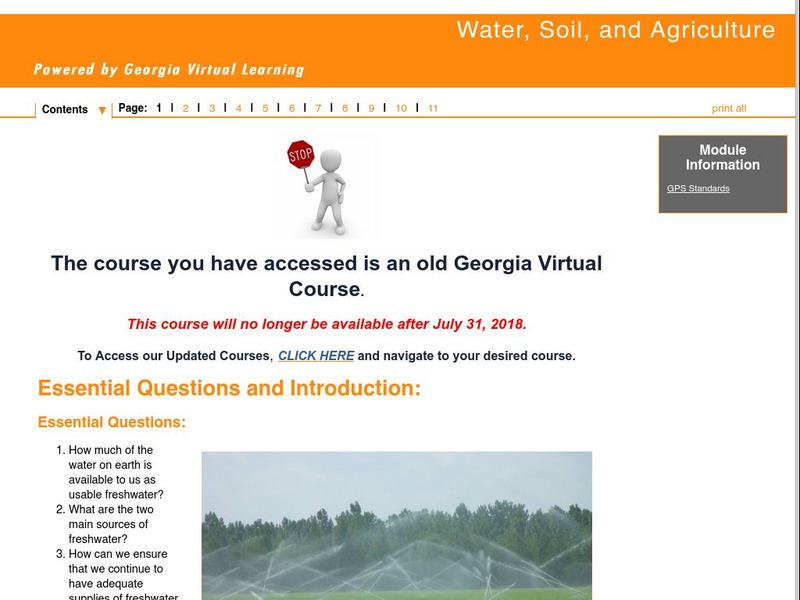Curated OER
Health, Pollution, and Safety: Why Should We Care?
Students examine the impact of reducing the carbon dioxide emissions. They identify ways alternative fuels can lessen the effect of emissions on communities. Working in teams they conduct research from various community and Internet...
Curated OER
The Water in Our Lives: Kit Practice
Learners examine a local water source using testing kits to determine water qualitiy. They identify the pollutants and contaminants in each sample. They determine if samples fall within an acceptable range for drinking water.
Curated OER
Water Quality
Students conduct experiments to study the quality of water. They examine how pollutants get into and affect the water supply in this unit.
Curated OER
A Tale of Two Reactors
Tenth graders role-play as members of the food chain. Sticky tables acting as polluting factors are introduced and members of different trophic levels suffer varying degrees of damage due to those pollutants.
Curated OER
Water Quality and Temperature
Students are led through three activities to explore the effect of temperature fluctuations on the growth and survival of aquatic plants, clams, and shrimp eggs.
Curated OER
Air Pollution and Health
Students use Internet research to become familiar with the environmental and health effects of the six criteria pollutants identified by the U.S. EPA, along with the greenhouse effect and carbon dioxide.
Curated OER
Finding and Measuring What You Can't See
Students determine how scientists measure pollutants in food and the environment. Students discover how scientists remove one material based on its physical properties. Students figure out how much of a pollutant is present after...
Georgia Department of Education
Ga Virtual Learning: Air, Atmosphere, and Climate Change
Sixteen essential questions lead student learning about Earth's atmosphere and global warming as they have to do with global climate change.
Yale University
Yale New Haven Teachers Institute: Atmospheric Changes
Lesson unit on the effects of fossil fuel burning on the atmosphere. Includes particulates with good materials balance.
US Environmental Protection Agency
Epa: Envirofacts Data Warehouse
Using zip codes, this site allows students to locate businesses in their communities that are producing wastes.
BioEd Online
Bio Ed Online: Air, Atmosphere and Living Systems
This unit includes a complete set of science lessons that enable students to creatively explore basic concepts related to air and the atmosphere, air quality, and associated issues, such as allergens in the places we live, study and work.
BioEd Online
Bio Ed Online: Bio Build Up
This activity allows learners to make a simple model food chain and observe how toxic chemicals can become concentrated in the bodies of consumers at the top of the chain.
Georgia Department of Education
Ga Virtual Learning: Ap Environmental Science: Toxicology and Human Health
Students investigate hazards to human health that are found where we live, work, and play, and begin to understand the risk analysis and system of evaluation that was developed to protect us from potential environmental dangers.
US Environmental Protection Agency
Epa: Acid Rain
What are the causes and effects of acid rain in our environment? To learn more about this serious environmental issue check out this website. Contains a page with several acid rain activities for students.
TeachEngineering
Teach Engineering: What's Hiding in the Air?
Students develop an understanding of the effects of invisible air pollutants with a rubber band and hanger air test and a bean plant experiment. They also learn about methods of reducing invisible air pollutants.
TeachEngineering
Teach Engineering: Environmental Engineering
In this unit, students explore the various roles of environmental engineers, including: environmental cleanup, water quality, groundwater resources, surface water and groundwater flow, water contamination, waste disposal and air...
NASA
Nasa Earth Observatory: Natural Hazards: Dust, Smoke, and Haze
NASA's Earth Observatory offers photographs of dust, smoke, and haze throughout the world. Learn how these pollutants can be hazardous to our Earth.
PBS
Pbs: Dimming the Sun
This interactive resource provides evidence that human air pollution is limiting the amount of sunlight that is reaching the earth's surface.
US Environmental Protection Agency
Epa: Criteria Air Pollutants
Find out about the six major air pollutants. In-depth descriptions of ozone, nitrogen dioxide, particulates, sulfur dioxide, carbon monoxide, and lead are provided.
TeachEngineering
Teach Engineering: Sensing Air Pollution
Students learn about electricity and air pollution while building devices to measure volatile organic compounds (VOC) by attaching VOC sensors to prototyping boards. In the second part of the activity, students evaluate the impact of...
Georgia Department of Education
Ga Virtual Learning: Water, Soil, and Agriculture
Students learn about the fundamental importance of water, soil, and agriculture in sustaining the human standard of living; and the heavy toll that current agricultural practices take on water and soil resources.
Center for Innovation in Engineering and Science Education, Stevens Institute of Technology
Ciese Real Time Data Projects: Size, Shape and Health Effects of Particulates
How does particulate pollution affect people with breathing disorders? Real time air quality data is provided for you to assess your state. Using this data you can determine who might be at risk in your particular area.
NASA
Nasa Earth Observatory: Global Maps: Aerosol Optical Depth
View Earth's aerosol optical depth by watching a global map evolve from January 2005 to November 2008. Learn about aerosol amounts such as volcanic ash, sea salt, smoke, and other pollutants.
Utah Education Network
Uen: Water Pollution Graphing: Bugs Don't Bug Me
Activity shows the link between land use activities within a watershed and water quality.

























